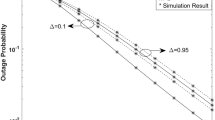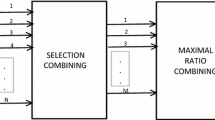Abstract
In an advanced wireless communication system, a smart receiver trims down the fading effect. From a practical point of view, performance such receiver depends not only on the estimation of channels but also system accuracy. This paper derives the general expression of average bit error rate (BER) and outage probability for dual-branch Maximum Ratio Combining (2-MRC) over Fluctuating Two Ray (FTR) fading channels with Imperfect Channel Estimation. Communication channels encountered in Fifth-Generation Millimeter-Wave communication is represented accurately by the FTR fading channels. A 2-MRC receiver is considered because of its performance advantage and less complexity. The probability density function of the output signal-to-noise ratio is obtained for 2-MRC receiver with channel estimation error over the FTR fading model. The mathematical description of average BER for both non-coherent and binary coherent modulation is derived. The impact of the fading parameters and the error estimation on the system efficiency are assessed through numerical analysis of the generated equations.





Similar content being viewed by others
Data Availability
Not applicable.
Code Availability
Not applicable.
References
Simon, M. K., & Alouini, M. S. (2008). Digital communications over fading channels. IEEE Transactions on Information Theory, 54(7), 3369–3370.
Devi, L. M., Das, N., Goswami, S., & Singh, A. D. (2019). A study on capacity of MRC over OWDP fading channels. In Advances in communication, devices and networking: Proceedings of ICCDN 2018 (pp. 229–238). Springer Singapore.
Rangan, S., Rappaport, T. S., & Erkip, E. (2014). Millimeter-wave cellular wireless networks: Potentials and challenges. Proceedings of the IEEE, 102(3), 366–385.
Rappaport, T. S., MacCartney, G. R., Samimi, M. K., & Sun, S. (2015). Wideband millimeter-wave propagation measurements and channel models for future wireless communication system design. IEEE Transactions on Communications, 63(9), 3029–3056.
Rappaport, T. S., Xing, Y., MacCartney, G. R., Molisch, A. F., Mellios, E., & Zhang, J. (2017). Overview of millimeter wave communications for fifth-generation (5G) wireless networks: With a focus on propagation models. IEEE Transactions on Antennas and Propagation, 65(12), 6213–6230.
Romero-Jerez, J. M., Lopez-Martinez, F. J., Paris, J. F., & Goldsmith, A. (2016). The fluctuating two-ray fading model for mmWave communications. In 2016 IEEE Globecom workshops (GC Wkshps) (pp. 1–6). IEEE.
Samimi, M. K., MacCartney, G. R., Sun, S., & Rappaport, T. S. (2016). 28 GHz millimeter-wave ultrawideband small-scale fading models in wireless channels. In 2016 IEEE 83rd vehicular technology conference (VTC Spring) (pp. 1–6). IEEE.
Zhang, J., Zeng, W., Li, X., Sun, Q., & Peppas, K. P. (2017). New results on the fluctuating two-ray model with arbitrary fading parameters and its applications. IEEE Transactions on Vehicular Technology, 67(3), 2766–2770.
Zhao, H., Liu, Z., & Alouini, M. S. (2018). Different power adaption methods on fluctuating two-ray fading channels. IEEE Wireless Communications Letters, 8(2), 592–595.
Olyaee, M., Eslami, M., & Haghighat, J. (2019). Performance of maximum ratio combining of fluctuating two-ray (FTR) mmWave channels for 5G and beyond communications. Transactions on Emerging Telecommunications Technologies, 30(10), e3601.
Laishram, M. D., & Aheibam, D. S. (2020). Performance of dual-branch selection combining receiver over Fluctuating Two-Ray (FTR) fading channels for 5G mmWave communications. AEU-International Journal of Electronics and Communications, 117, 153093.
Das, D., & Subadar, R. (2019). Performance analysis of QAM for L-MRC receiver with estimation error over independent Hoyt fading channels. AEU-International Journal of Electronics and Communications, 107, 15–20.
Ma, Y., Schober, R., & Pasupathy, S. (2005). Effect of channel estimation errors on MRC diversity in Rician fading channels. IEEE Transactions on Vehicular Technology, 54(6), 2137–2142.
Saikia, B., & Subadar, R. (2019). Effect of estimation error on dual MRC receiver over Hoyt fading channels. International Journal of Electronics Letters, 7(4), 400–409.
Singh, A. D., & Kumar, N. A. (2015). On effect of diversity order on the SNR of M-SC Receivers over TWDP fading channels. In International conference on computing and communication systems (I3CS’15) (pp. 9–10).
Devi, L. M., & Dinamani Singh, A. (2020). The performance of coherent and non-coherent modulation in FTRF channels. In Proceedings of the 5th international conference on computers & management skills (ICCM 2019)| North Eastern Regional Institute of Science & Technology (NERIST), Nirjuli, Arunachal Pradesh, India.
Romero-Jerez, J. M., Lopez-Martinez, F. J., Paris, J. F., & Goldsmith, A. J. (2017). The fluctuating two-ray fading model: Statistical characterization and performance analysis. IEEE Transactions on Wireless Communications, 16(7), 4420–4432.
Srivastava, H. M., & Karlsson, P. W. (1985). Multiple Gaussian hypergeometric series. E. Horwood Halsted Press.
Ma, Y., Schober, R., & Pasupathy, S. (2005). Performance of M-PSK with GSC and EGC with Gaussian weighting errors. IEEE Transactions on Vehicular Technology, 54(1), 149–162.
Jeong, W., Lee, J., & Yoon, D. (2011). New BER expression of MPSK. IEEE Transactions on Vehicular Technology, 60(4), 1916–1924.
Subadar, R., & Singh, A. D. (2013). Performance of SC receiver over TWDP fading channels. IEEE Wireless Communications Letters, 2(3), 267–270.
Devi, L. M., & Singh, A. D. (2021). Performance analysis in terms of bit error rate over fluctuating two-ray (FTR) fading channels. Wireless Personal Communications, 118, 889–899.
Gradshteyn, I. S., & Ryzhik, I. M. (2014). Table of integrals, series, and products. Cambridge: Academic Press.
Funding
No Funds by any agency.
Author information
Authors and Affiliations
Contributions
All the authors are equally contributed.
Corresponding author
Ethics declarations
Conflict of interest
The authors declare no conflict of interest.
Additional information
Publisher's Note
Springer Nature remains neutral with regard to jurisdictional claims in published maps and institutional affiliations.
Rights and permissions
Springer Nature or its licensor (e.g. a society or other partner) holds exclusive rights to this article under a publishing agreement with the author(s) or other rightsholder(s); author self-archiving of the accepted manuscript version of this article is solely governed by the terms of such publishing agreement and applicable law.
About this article
Cite this article
Devi, L.M., Singh, A.D. Effect of Channels Estimation Error on the System Performance of 2-MRC Receiver over Fluctuating Two-Ray (FTR) Fading Model for 5G mmWave Communication. Wireless Pers Commun 134, 901–913 (2024). https://doi.org/10.1007/s11277-024-10936-4
Accepted:
Published:
Issue Date:
DOI: https://doi.org/10.1007/s11277-024-10936-4




